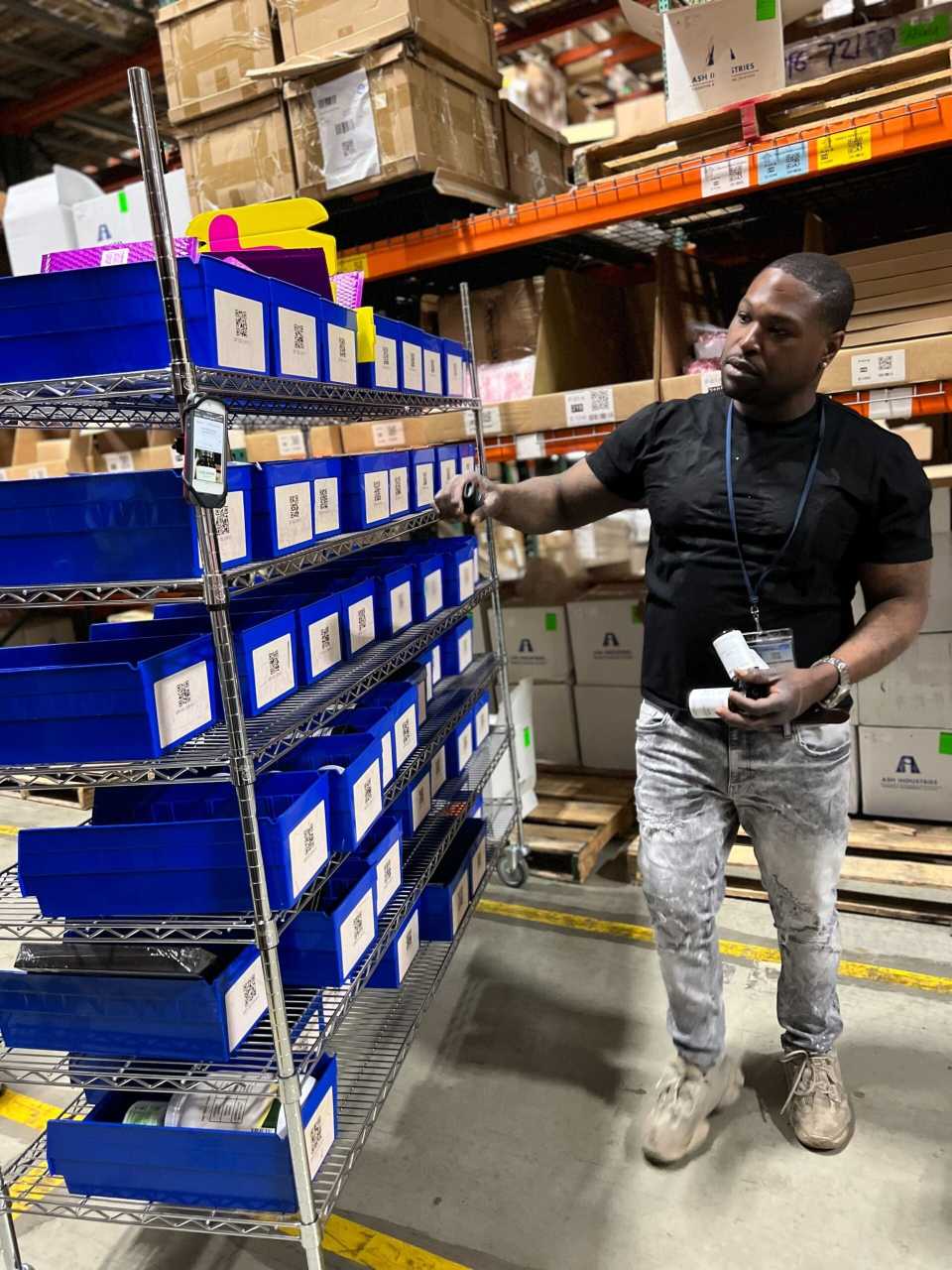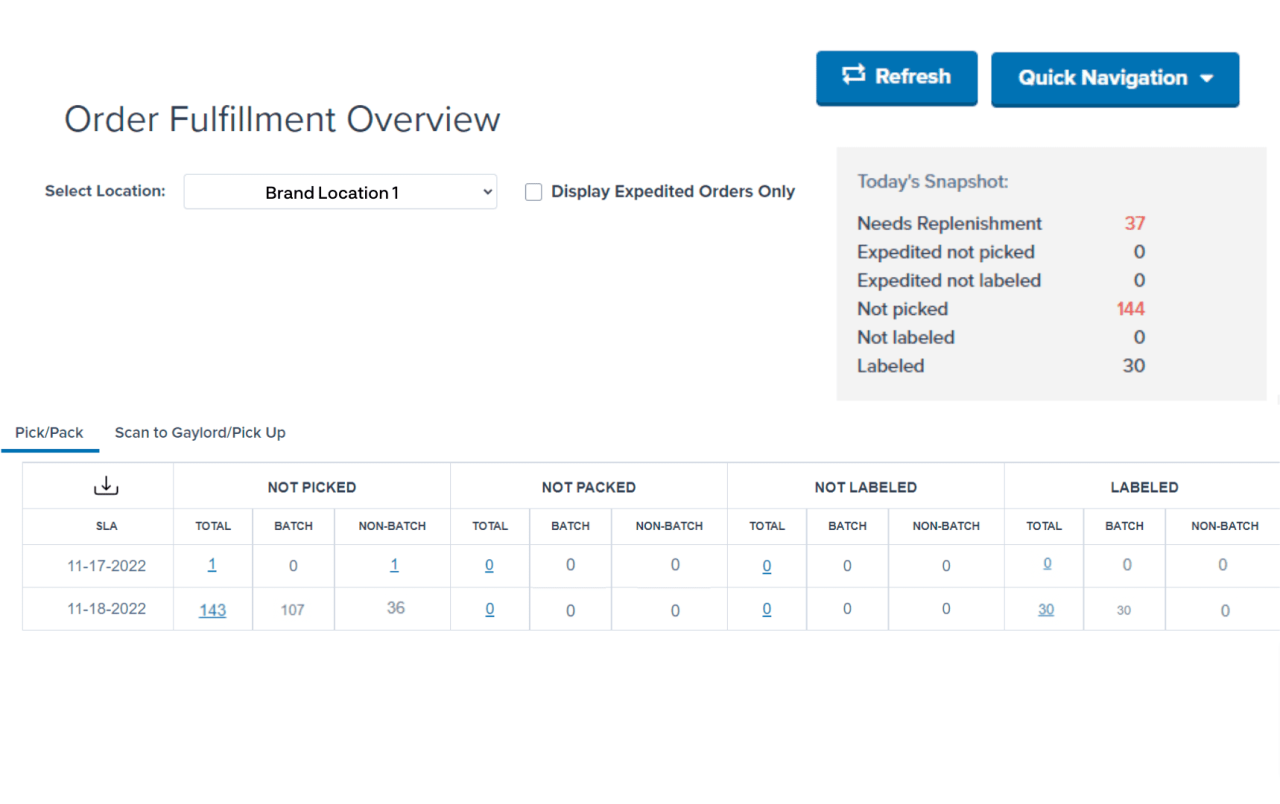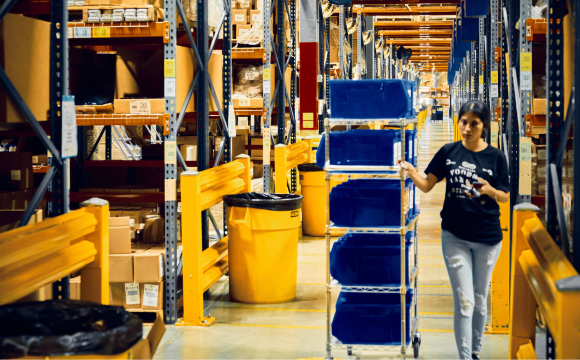Doing tasks one at a time can be helpful – but that’s rarely the case in ecommerce picking.
Imagine your brand stores inventory in a huge fulfillment center, and pickers can only pick a single item for an order at a time. It might take them ages to walk all around your facility, picking up an individual product, and bring it back to their packing station before leaving to find the next one. Unsurprisingly, it also guts your operational efficiency.
This is why a lot of ecommerce brands opt to leverage tote picking. By picking-to-tote, warehouse associates can spend less time walking around a warehouse and pick far more orders with less effort.
In this article, we’ll unpack the pick-to-tote strategy, compare it to other picking strategies, and discuss how to optimize pick-to-tote systems with the right technology and partners.
What is pick-to-tote (warehouse tote picking)?
Pick-to-tote is a warehouse order picking strategy in which pickers pick and place items for an order directly into designated receptacles (also known as totes).
This enables pickers to pick all items for an order in one trip through a warehouse, instead of walking back and forth from storage to a packing station after picking each individual item. This, in turn, allows for more efficient handling and improves overall picking efficiency for high-volume order fulfillment.

Overview of the pick-to-tote process
The pick-to-tote process begins with a warehouse management system (WMS) generating a picking list that’s assigned to a dedicated picker. These picking lists include the items and quantities in each order, as well as the optimal route through the warehouse for minimal walking.
Tote picking is a type of batch picking, meaning that pickers will almost always pick multiple orders at totes at a time. Each order gets its own dedicated tote, and the picker brings multiple totes with them as they move around the warehouse.
The picker transports the totes using a pick cart, and travels through storage areas to retrieve items from their assigned list.
Once they retrieve an item, the picker deposits it into a dedicated bin for the order, where it’s grouped with other items from the same order. That way, each order’s contents is already separated from the others once they’re sent to the next stage of fulfillment.

Benefits of pick-to-tote for warehousing efficiency
With pick-to-tote, all the items needed for an order are picked during the same trip through the fulfillment center. This minimizes the need to go back and forth between stations, reducing travel time and improving picking efficiency. Moreover, it helps to improve order accuracy, since tote picking makes it easier to see what items in what quantities have been picked for each order, which minimizes duplicate or missed items.
Common use cases for pick-to-tote in order fulfillment
While any warehouse of fulfillment center could use the pick-to-tote method, it’s particularly suitable for:
1) Like orders or batches – If you receive lots of orders that share many of the same products, tote picking saves pickers the hassle of revisiting the same location multiple times. Instead, by grouping similar (or even identical) orders on the same cart, pickers can pick multiple items from a single storage location and add them to different orders’ totes to essentially pick multiple orders simultaneously.
2) High-volume operations – If your brand must get orders out the door as soon as possible, tote picking minimizes repetitive actions and reduces travel time, helping your team pick orders faster. Tote picking also makes it easier to verify that each order is complete and accurate, which is crucial (as rushed picking is often more prone to fulfillment errors).
How pick-to-tote compares with other picking methods
Pick-to-tote vs. pick-to-carton
In the pick-to-carton approach, items are picked and placed directly into the carton that will be used for shipping. This makes pic-to-carton ideal for companies that sell products that are all of similar size and weight.
| Pros | Cons | |
| Pick-to-Carton | Eliminates the need for a dedicated packing process Streamlines order sorting and handling to improve efficiency | Requires pickers to determine correct carton sizes before picking Higher risk of order errors (as packers have less opportunity to identify mispicks or missing items before shipping) |
| Pick-to-Tote | Does not require pickers to determine the optimal packaging size for each order Higher order accuracy (as packers usually have the opportunity to identify mispicks or missing items before shipping) | Requires an additional packing process May require additional time for sorting and handling during packing |
Pick-to-tote vs. pick-to-belt
In the pick-to-belt approach, items retrieved from storage are directly transported to packing stations using conveyor belts. This may speed up the picking process for high-volume operations but also comes with a few disadvantages.
| Pros | Cons | |
| Pick-to-Belt | Allows picked items to quickly move on to the next stage of fulfillment Minimizes the need for manual handling, allowing you to save on labor costs | Requires high initial investment (as conveyor belt systems can be expensive) High risk of damage when transporting more fragile items |
| Pick-to-Tote | Require less investment in physical equipment (as carts and totes are usually less expensive than mechanical equipment like conveyor belts) Supports more careful material handling | Pickers must first retrieve all the items from an order before moving it to packing stations Requires a more hands-on approach to item handling |
Check out ShipBob's Warehouse Management System (WMS)
ShipBob's WMS helps your warehouse reduce picking errors, manage inventory in real time, and fulfill orders faster.
How to choose the right picking method for your operations
With multiple approaches to picking out there (including wave picking and zone picking, not described here), it can be hard to know if you’re using the right one. Before investing a significant amount of resources in one pick method, make sure you consider differnet factors of your business, including:
- The size of your operations
- The volume of orders you plan to fulfill
- The types of products you’re selling, as well as their features (e.q.; size, weight, fragility, etc.)
- The level of accuracy you want to maintain
For example, pick-to-carton may be ideal for businesses dealing with a smaller product range, while pick-to-belt may be suitable for those with high-volume orders. Pick-to-tote, on the other hand, is ideal for businesses that fulfill lots of multi-item orders to ensure fulfillment accuracy.
“I also love what ShipBob WMS has done for our fulfillment operations. With our old solution, there was no real method or any sort of organized way to pick orders; ShipBob’s WMS, on the other hand, offers many different flexible picking options that direct and optimize picking flows for us.
We use cluster picking, where ShipBob’s WMS automatically groups orders with common items together, assigns them all to one cart, and calculates the best route to take us through our warehouse and pick all those orders at the same time. Our fulfillment is so much more efficient now – we can easily ship 1-2K orders a day, no problem.
Before, averaging 15K orders a month would have been a struggle – but with ShipBob WMS, it’s a breeze. That capacity has been crucial to getting each customer their tracking number and their order out on time, which helps us win business and get even more orders.”
Tim Poyer, VP of Operations and Logistics at Elwood Clothing
Technology and tools that optimize pick-to-tote systems
Tote picking is already an efficient picking strategy, but it’s made even more efficient when ecommerce brands power it with the right tools. Here are just some of the technologies that brands can leverage to further enhance their pick-to-tote performance.
Barcode scanning and automated sorting systems
Pickers can use barcode inventory scanners to check each item they pick against the order’s details and improve picking accuracy. It also speeds up the picking process by minimizing the need to manually check that they have the correct item.
Additionally, businesses can leverage automated sorting systems and other warehouse automation solutions to improve efficiency. This involves using tote barcodes and RFID scanners to automatically route bins to the right locations as they get transported using conveyor belts, eliminating the need for pickers to manually travel to packing stations, reducing travel time, and speeding up fulfillment.
“ShipBob’s WMS has completely transformed our operations. It makes the receiving process very easy and straightforward, and the stowing tag system that’s built into the WMS has been so helpful. We also have a dedicated location for every SKU and corresponding barcodes that pickers scan to update inventory counts in the ShipBob dashboard in real time, which we never had when we were managing inventory through Shopify. Everything is so seamless now, even with thousands of SKUs in our portfolio.”
Tim Poyer, VP of Operations and Logistics at Elwood Clothing
Voice-picking technology for pick-to-tote
Businesses can speed up the pick-to-tote process by incorporating voice picking systems. This involves pickers receiving verbal instructions through a headset on which items to pick for each order and where in the warehouse to go. That way, they can remain hands-free and seamlessly retrieve items needed to fulfill orders from their assigned pick lists.
This can significantly enhance productivity, as workers won’t have to scan barcodes to periodically consult their picking lists every time, as well as picking speed – all while helping to reduce errors.
Goods-to-person (G2P) systems for efficient tote picking
Warehouses leveraging goods-to-person systems can significantly speed up the tote picking process by bringing items to pickers, rather than pickers walking to an item’s storage area. These systems typically use automated storage and retrieval systems (AS/RS) for boxes or shuttle systems, which automatically send the necessary inventory to the pick stations. Pickers then retrieve the items they need from these boxes and place them into their respective bins.
U-shaped conveyors are also popularly used in pick-to-tote systems, where boxes are brought to the workstations of operators. The operators will then remove the items and deposit them into dedicated bins before moving them to the packing area.
Who benefits most from tote picking in a warehouse setting?
Considering the ease and efficiency of tote picking, this pick method can be particularly beneficial for certain types of businesses.

Growing ecommerce brands
Even when an ecommerce brand is experiencing high growth with tons of orders coming in, they still need to meet high customer expectations to sustain that growth. Picking-to-tote can help brands deliver fast and accurate orders and effectively meet customer demand.
However, the pick-to-tote strategy does require equipment, like bins, carts, and inventory scanning systems – resources that brands might not have the captial to purchase in the early stages of their growth. In these instance, partnering with a 3PL – or better yet, an expert fulfillment provider like ShipBob – that leverages tote picking allows DTC brands to efficiently manage their growth without the need to invest in extensive in-house logistics.

Established retail brands
Established retail brands consistently operate high-volume fulfillment environments (especially with the rise of multichannel retailing), so there’s always a need for these brands to prioritize cost savings and efficiency improvements.
Tote picking streamlines warehouse logistics at scale, allowing large retail brands to seamlessly pick and fulfill thousands of orders across multiple channels. This enables them to effectively handle large volumes of orders while achieving cost-savings through productivity gains and reduced labor needs.

Health and beauty brands
It’s not uncommon for brands selling products related to beauty or health and wellness to deal with diverse SKUs and products that are typically small and fragile. This makes it particularly important to maintain safety and accuracy during the picking and handling process.
Tote picking reduces the risk of mix-ups and damages during picking, ensuring careful handling and order customization. A fulfillment partner that’s well-versed in both tote picking and the specific fulfillment needs of health and beauty brands can also improve operational efficiency and accuracy.
How ShipBob supports efficient pick-to-tote operations
As an expert supply chain enablement platform, ShipBob offers both outsourced and in-house solutions for ecommerce brands looking to optimize their picking processes. Whether you store your inventory across any of ShipBob’s dozens of fulfillment centers worldwide or power your own facility with ShipBob’s WMS, our setup and technology lets you leverage flexible picking options and fulfillment best-practices for streamlined, cost-effective fulfillment.
Here are just a few of the ways that ShipBob helps brands achieve faster, more accurate picking.
Advanced WMS for real-time inventory and tote tracking
Shipbob WMS gives you full, location-specific visibility into your inventory storage and warehouse operations to make picking and packing a breeze.
Your picking staff can easily coordinate their movement across your facility, identify the right locations, and verify their picks through a barcode scanning process with built-in checks and balances to enhance accuracy and reduce fulfillment errors.
“The technology employed by ShipBob guarantees accurate deliveries to our customers. ShipBob’s warehouse management system is equipped with numerous checks and balances, minimizing the possibility of incorrect items being shipped by warehouse associates.”
Ali Shahid, COO of Our Place
Data-driven insights for continuous process improvement
ShipBob’s WMS comes with built-in capabilities to track various performance metrics across your warehouse operations. This allows you to easily monitor KPIs to understand picking efficiency and order accuracy. You can then use these insights to optimize your warehouse management strategy and make ongoing improvements to your tote picking strategy.

Flexible capacity for scaling brands
ShipBob’s picking strategies and hybrid fulfillment solutions are designed to flex and scale with your brand as it grows to new heights and into new markets.
Every fulfillment center in ShipBob’s network is powered by ShipBob WMS, delivering seamless standardization across any ShipBob facility your brand fulfills from. You can even leverage ShipBob’s fulfillment centers in tandem with your own warehouse(s), giving you a way to expand geographically (and even globally!) without investing capital that’s needed elsewhere.
ShipBob also offers key fulfillment features and capabilities you may need as you scale, including:
- Support for custom branded packaging, inserts, and gift notes for personalization that pops
- Automated inventory allocation and placement to cut shipping times and costs
- Omnichannel fulfillment for DTC and B2B channels to reach customers anywhere they shop
- Integrations with dozens of ecommerce tools, marketplaces, and partners for a tailored tech stack
“There are so many growth opportunities on the table for us – and because ShipBob offers so many different solutions and growth levers, we’re able to leverage our existing partnership to scale instead of having to go out and find different providers for every new expansion.”
Jessica Cedarleaf, VP of Operations at Tonies
For more information on how ShipBob can help you optimize the picking process and more, click the button below to get in touch.
Pick-to-tote FAQs
Below are answers to the most commonly asked questions about the pick-to-tote strategy.
How is pick-to-tote different from batch picking?
Batch picking is a picking method that involves grouping multiple orders into one pick batch. Pick-to-tote is a common type of batch picking method, where a picker retrieves multiple items from the orders assigned in their pick batch and places them into dedicated bins for each order.
Can pick-to-tote reduce labor costs in fulfillment?
Pick-to-tote can reduce labor costs by minimizing unnecessary movements and reducing travel time. Since picking staff can fulfill more orders efficiently, it can help to reduce the overall labor required to fulfill your orders.
How can pick-to-tote improve order accuracy in ecommerce?
Pick-to-tote processes allow picking staff to verify each pick and sort them into their respective bins. With the items in each order going through that initial sorting during the picking process, it can significantly improve order accuracy.








